Claussen Pickles are kosher dill pickles at their crunchiest, saltiest best! These homemade Claussen pickles taste like the commercial ones you find at the store, but better. And better yet, they’re ridiculously easy to make!
Whether you’re new to pickle making or a pickle veteran, you NEED to make these half sour pickles! And wonder of wonders, you don’t need to know how to can to make these super fresh, crunchy pickles! Claussen dill pickles are meant to be eaten fresh.
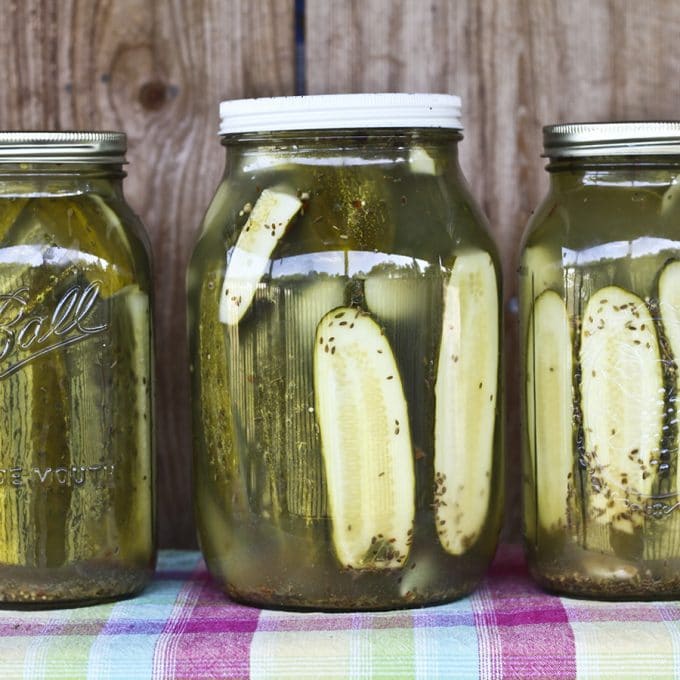
Homemade Claussen Knock-Off Pickles: Always crunchy and garlicky, this perfect homemade pickle recipe requires no special equipment, & no canning experience.
It’s common knowledge that I have a salty tooth rather than a sweet tooth. When the weather does what it has been doing lately (making us all do our best Shadrach, Meshach and Abednego impersonations) I can’t think of a single thing I find more refreshing than an icy-cold, salty, crunchy pickle.
It’s not just me, it’s my whole family: mother, sisters, brothers, cousins, aunts, grandparents, kids, husband… I married a man who loves pickles so much he eats the pickles and then drinks the juice from the jar.
I grew up eating my Grandma’s homemade dill pickles like the supply was endless and moved on to canning my own pickles as soon as I had a kitchen of my own. There’s just something about a homemade dill pickle that makes me happier than any pickled cucumber ever should.
My little sister, Jessamine, and I compare our homemade pickles from year to year the way some people compare wine vintages.
Dill Pickle Recipe
But there is one pickle that stands head-and-shoulders (were pickles to *have* heads and shoulders) above all others. I’m talking about the pickles you see here. That’s right: Homemade Claussen Dill Pickles.
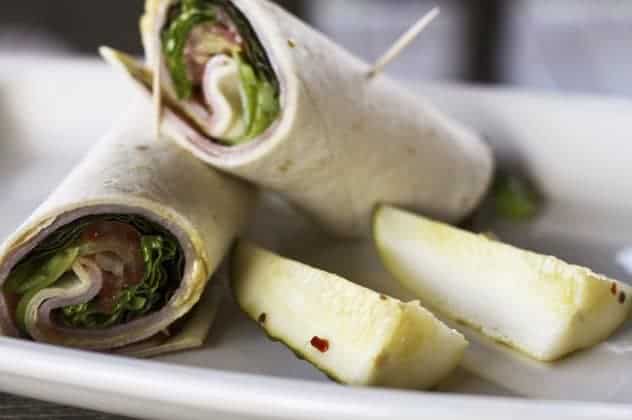
Recipe for Claussen Pickles
What do you need in order to make this recipe for Claussen Half Sour Pickles at home? Let’s get a quick list for both ingredients and equipment out of the way, shall we?
Equipment for Making Claussen Pickles at Home
- A Glass gallon jar or 4 glass quart jars or other food safe container with a tight fitting lid
- Measuring cup
- Chef’s knife or paring knife
Ingredients for Making Homemade Claussen Pickles Copycat
- Small to medium size pickling cucumbers (check your local farm stand or farmer’s market!)
- Apple Cider Vinegar (don’t fret- it doesn’t taste like apple cider and isn’t even a little sweet!) or white vinegar
- Kosher Salt
- Garlic
- Dill (either fresh or dill seed)
- Pickling spices (available here)
A quite note on your vinegar choice: I opt for apple cider vinegar because it’s a smoother vinegar than white vinegar. It does not impart any sweetness or apple taste to the pickles whatsoever.
If you can’t find it (pssst. It’s right next to white vinegar in even moderately stocked grocery stores) or don’t feel like buying it, you can most certainly substitute white vinegar. It’ll just taste a little sharper. (And technically store bought Claussen pickles have white vinegar, so you do you!)
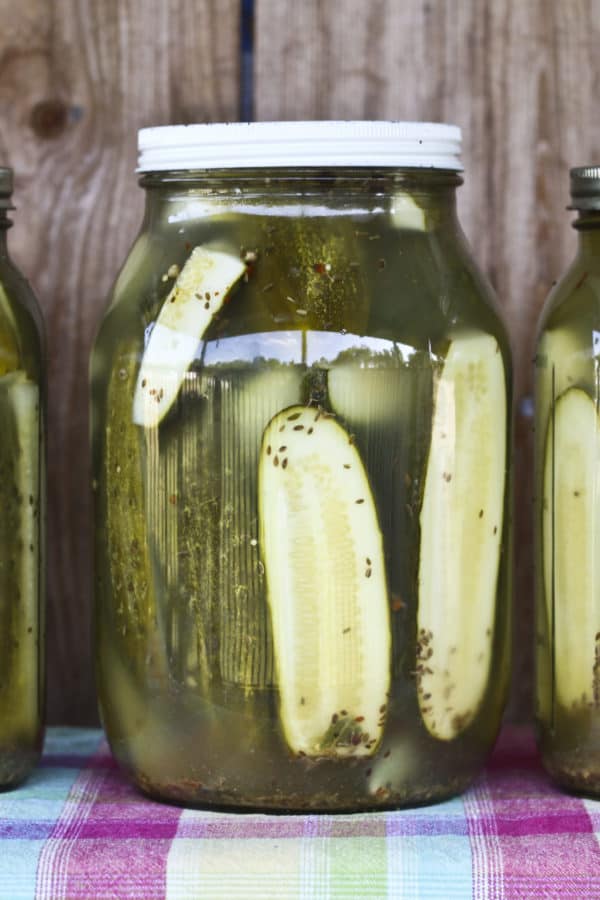
And ya’ll. These homemade half sour pickles are so easy to make it’s almost criminal.
The hardest part is the 2 to 4 day wait for them to be done. Truth be told, though, I’ve snacked on them the day after I made them and been a very happy camper.
Claussen Pickle Recipe
These are homemade refrigerated deli pickles, also known as Lithuanian half-sours, also known (in the commercial equivalent) as Claussen dill kosher pickles, also known as the best pickles ever known to mankind.
Here’s the thing. While I do love my other homemade pickles dearly (otherwise why would I continue canning ninety-something quarts year after year after year), these are by far my all-time favourites.
CRUNCH. That’s what you hear when you bite these. There is no flop, no squish, no soft pickles. These things almost bite back.
This also happens to be the perfect dill pickle recipe for beginning pickle makers. If you’re not into canning, these refrigerator pickles are a godsend. Even if you ARE canning obsessed, like yours truly, this Claussen pickle recipe should be in your pickle repertoire too.
Please note that this Claussen pickle recipe is not suitable for canning. The brine is fermented and not very acidic, which means it has far too high a PH to can safely. If you’re looking for a great canned dill pickle recipe, try this home canned garlic dill pickle recipe.
Refrigerator Pickles
Here’s where we get into the best part of this pickle recipe (aside from the crunch and flavor). You don’t have to cook anything to make these pickles; not one single thing. The brine is stirred together, the cucumbers are rinsed, trimmed and stuffed into a jar with garlic cloves and spices.
These half sour pickles are NOT CANNED. They are simply put into jars. Amen!
When it’s summer time and the idea of turning on the stove makes me want to crawl into an (air conditioned) hole, these pickles are a welcome treat. Not only is that cold crunchy refrigerator pickle waiting to cool me off at the end of the prep time, but I don’t have to heat up my kitchen by even one single degree to get there.
Remember that pickling isn’t just for cucumbers, either! Try out our Pickled Brussels Sprouts, Quick Pickled Red Onions, and famous Candied Jalapenos!
How to Make Pickles FAQ
Please, please, please give these a go even if you have never made a pickle before. There is nothing scary or intimidating here. Wash, slice, stuff, stir, pour, sit, wait.
- Trim 1/8-inch from the blossom end of each cucumber and slice them in half lengthwise or into quarters. The size you choose depends on how large your cucumbers are and how big you want the pickles to be when they’re done. This helps minimize the chances of soft pickles.
- In a gallon jar (or large, wide-mouth, food-safe container) layer the dill heads or seed, pickling spice or mustard seed, and garlic cloves and sliced cucumbers. If you’re dividing the cucumbers up between smaller containers, just divide the garlic and spices evenly between the containers, too.
- Stir your brine together in a separate container. You WILL have more brine than you have space for in the jars, but that’s why you pack the spices in the jars. Just store extra brine in a jar in the refrigerator and use it to top off your pickles if the brine starts evaporating.
- Pour the brine over the cucumbers, taking care to make sure all of them are fully submerged. If needed, place a plate or mug or other ziploc bagged can of beans on the cucumbers to weigh them down and keep them under the brine!
- Cover the jars lightly not tightly and leave out of direct sunlight on the counter for two to four days or until the pickles are picklicious.
- If your kitchen is pretty hot or humid, you can stash them directly in the refrigerator. They’ll just take a couple of days longer to get fabulous. Your patience will be rewarded.
On the plus side, the wait is only two to four days which is significantly less than the six week wait of the canned pickles. Besides, as I said, there is the crunch factor
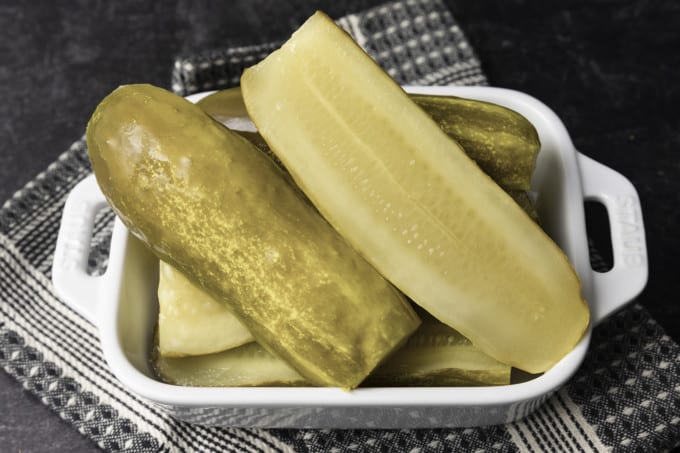
Troubleshooting Your Homemade Claussen Pickles
These pickles are easy peasy to make, but there still may be a couple of things that pop up from time to time that make you go “Hmmm…” In no particular order, here are some of the most commonly asked questions about them and some answers!
- Why is my pickle brine cloudy? Okay, I lied. This is the most common question and that’s because the brine becomes cloudy naturally as a consequence of fermentation (which is what’s happening here.) No worries.
It’s all natural. This half sour pickle recipe (more on this to come) is a fermented pickle recipe and that just happens.
Another possible cause of intense cloudiness or discolouration in your brine is using table salt. The iodine in table salt can also give off flavours to your pickles, so it’s best to stick with kosher salt or pickling salt for these bad boys! - Is the scum, foam, or film on top of my pickle brine dangerous? It’s that pesky (and delicious) fermentation again! This is another thing you don’t have to worry about.
Just scrape it off with a spoon, discard, and top off with a little of that extra brine you whipped up. (See the recipe card for details.) But do remove the scum or it could cause your pickles to go bad. - My pickles went soft! How do I prevent this? This particular tragedy could have two causes.
First, you may have failed to remove enough of the blossom end of the cucumber. There is a naturally occurring enzyme in the blossom end of cucumbers that causes pickles to break down and become soft if it is not removed. Next time, just slice more off.
Second, you may have started with less than spectacularly fresh cucumbers. An older cucumber has had longer for the aforementioned enzyme to kick in, and it has already started its work.
The best solution for this issue is to use cucumbers that have either been picked fresh that day or have been refrigerated steadily since very shortly after being picked a couple of days previously. - Why did my pickles go bad? See that second reason in the “why did my pickles go soft” bullet point? That’s one culprit.
Other potential causes of spoiled pickles are using unwashed cucumbers or fresh dill, old or decayed garlic, bad spices, lower-than-5%-acidity-vinegar, failing to remove the scum from the brine or to keep the pickles submerged in the brine, or storing your pickles in warmer conditions. When in doubt, stash them in the refrigerator! - Why is there mold on my pickles? First, you have my condolences. Second, it’s because your pickles didn’t stay submerged in the brine. That brine has enough salt and acid to prevent mold growth if the cucumbers stay under the surface.
If you’re having trouble finding something that fits in the jar to keep this from happening, try popping a can or two of tomato paste or canned beans in a zipper top bag and gently inserting that into the jar. It should weigh it down enough to do the job. - Should I worry about the white sediment in my jar? This is another one in the “don’t sweat it” category. There are two potential reasons and both are completely harmless.
It’s either a natural consequence of the fermentation or anti-caking agents in the salt. Neither harms the pickles or effects the flavour, so don’t worry! - Why is my garlic blue/green/purple? As long you inspect the garlic before it goes into your jars and it is fresh as a daisy, you have nothing to worry about. It could be the type of salt you used or it could be the variety of garlic. Some types of garlic have a natural propensity to change pretty colours in vinegar.
It also may mean that your pickles were exposed to light. When garlic is exposed to light, it starts producing chlorophyll which is green. It also may indicate that your garlic is more mature.
In that case it is caused by sulfur compounds that naturally occur in more mature garlic reacting with minute traces of copper in the vinegar., but as long as there are no other signs of spoilage (soft or squishy texture, funky smell, discoloured spots), you’re good to go.
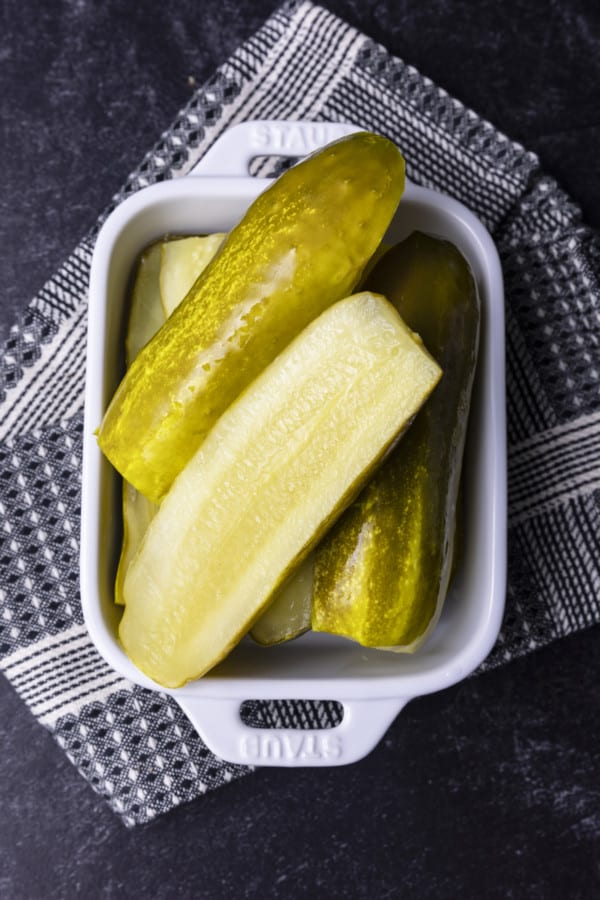
IMPORTANT NOTE: Because there is so much diversity in temperature, humidity, age of cucumbers, etc… involved in this recipe, please check your half sour pickles starting at 24 hours for doneness. If the pickles smell/taste pickley, move them to the refrigerator. Do not keep them on the counter longer than 4 days.
ANOTHER IMPORTANT NOTE: These pickles are not suitable for canning. They’re simply not acidic enough to can safely, and that is in addition to the fact that you’d ruin that perfectly crisp texture by introducing heat to the party.
What can I serve with these Homemade Claussen Knock-Off Pickles?
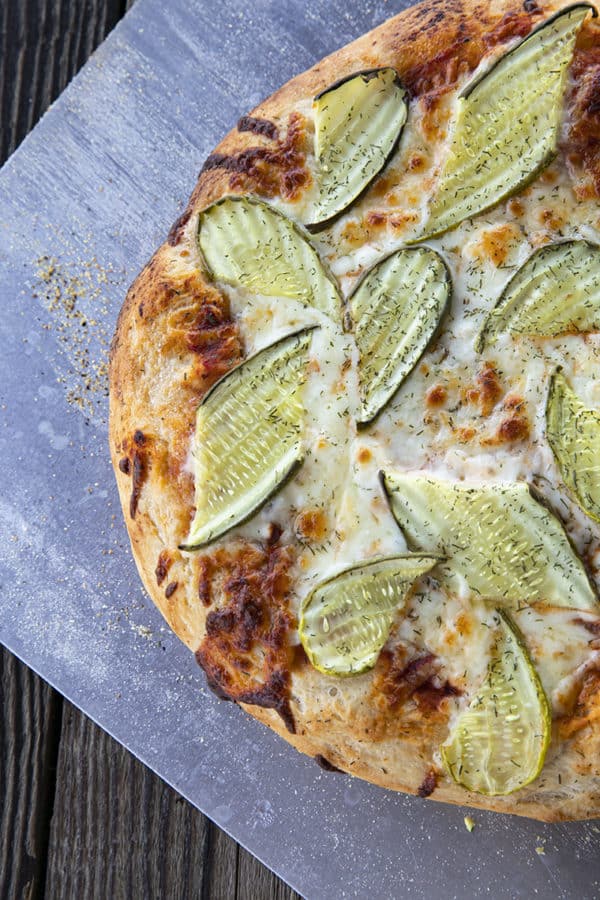
Start out by trying your half sour pickles in this Pickle de Gallo, Dill Pickle Dip, Dill Pickle Egg Salad, or Bagel Burgers with Dill Pickle Cream Cheese.
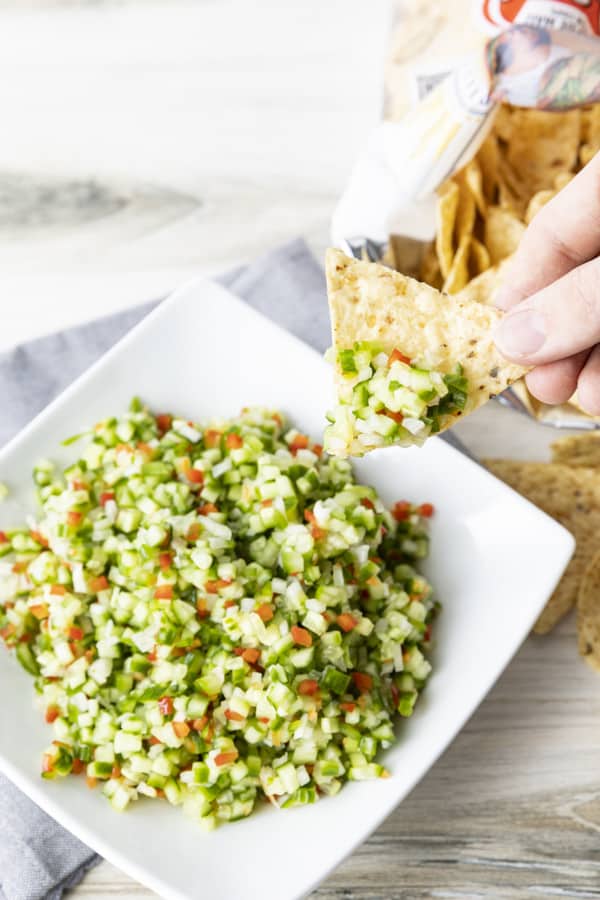
Even better, serve them on our Cheeseburger Salad or Pickle Pizza.
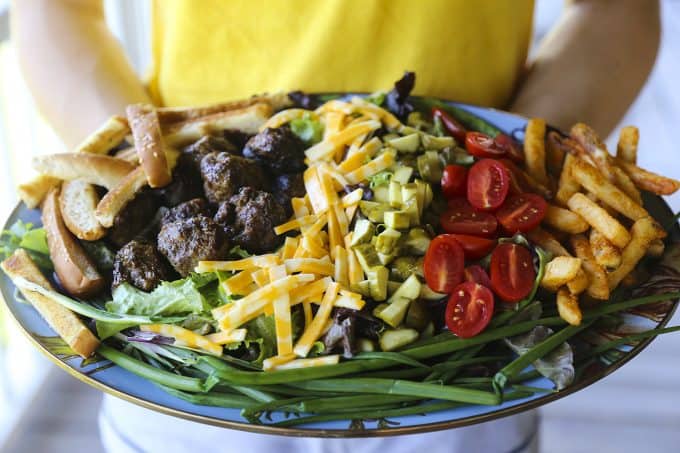
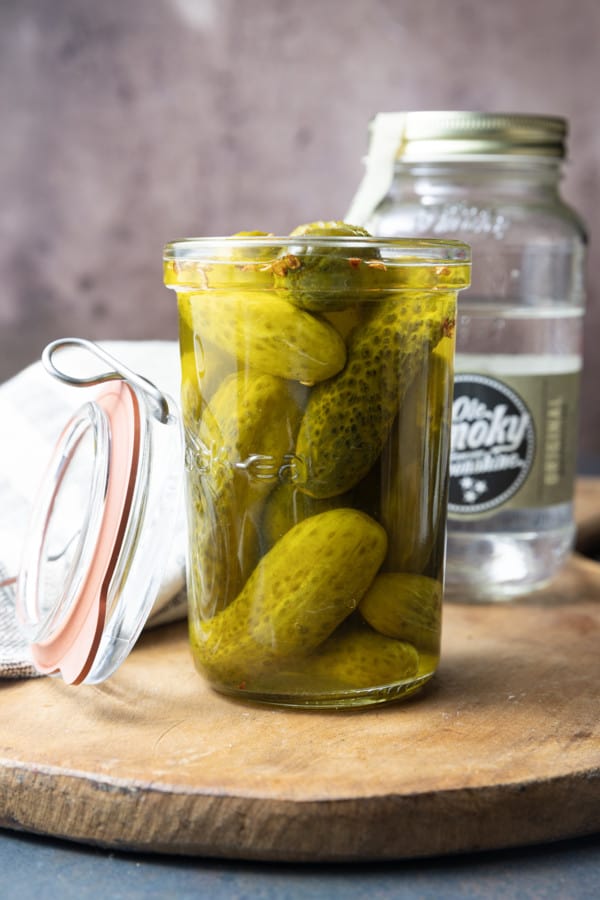
You can even take extra pickles (like that’s a thing!) and make these divine Moonshine Pickles. You’ve never had a better Bloody Mary than one made with homemade Moonshine Pickles!
Half Sour Pickle Recipe
What makes Claussen PIckles different from canned pickles? Claussen pickles, whether homemade or store bought, are a half sour pickle recipe.
That means they’re fermented instead of heat processed. That’s what gives them such great texture.
This half sour pickle recipe yields pickles that are crunchy to the point of making noise when you bite them, cold, and seriously garlicky. Canned, shelf-stable pickles can be chilled, maintain some crunch, and be as garlicky as you want them to be, but they are never, ever going to be the same thing because of science.
When you heat process a jar of pickles you are, in actuality, cooking it and a cooked pickle just plain can’t be as crunchy as an un-cooked half sour pickle recipe.
These homemade pickles keep well in the fridge for about six months, as long as they remain submerged in the brine. In our house, they never last that long because, as the saying goes, “A pickle a day keeps sad times away.”
They say that right? Someone must. If not, I’m going to start. It’s true, after all.
Claussen Pickles
Wash cucumbers but do not scrub them.
Trim 1/8-inch to 1/4-inch from the blossom end of each cucumber and slice in half lengthwise or into quarters, depending on how large your cucumbers are and how big you want them to be when they’re done.
Layer the dill heads or seed, garlic cloves, pickling spices and sliced cucumbers in a gallon jar (or large, wide-mouth, food-safe container). You can evenly divide the dill, garlic cloves, pickling spices, and cucumbers between several smaller jars if needed.
In a separate pitcher or bowl, stir together the remaining ingredients until the salt is dissolved.
Pour the brine over the cucumbers, taking care to make sure all of them are fully submerged. If needed, place a plate or mug or other non-reactive heavy item on the cucumbers to weigh them down and keep them under the brine!
Cover lightly with a lid just perched on top or secure a piece of cheesecloth over the jar with a rubber band to keep fruit flies away. Store any extra brine in a covered jar or pitcher in the refrigerator and use it to top off the brine if it starts to evaporate and expose the pickles to the air.
Leave out of direct sunlight on the counter for at least 24 hours, but up to 4 days, or until the cucumbers taste like pickles throughout.
Fix your lid onto your jar or container and chill thoroughly. These can be stored in the refrigerator for up to six months provided you keep them covered with brine.
NOTE: If at any point in the proceedings “fuzz” or “foam” develops on top of the brine, use a spoon to remove it. If there is “fuzz” attached to any of the cucumbers, remove the ones affected and be sure the others are still fully submerged.
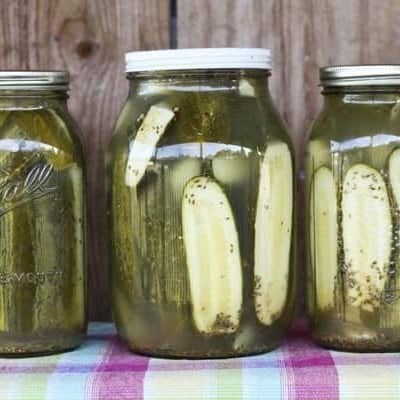
Homemade Claussen Knock-Off Pickles
Equipment
- 1 gallon jar or 4 quart jars or a large, food-safe container with a tight fitting lid
- 1 liquid measuring cup
- 1 large mixing bowl or pitcher
Ingredients
- 35 to 40 small to medium pickling cucumbers
- 1 gallon cold water
- 1 cup apple cider vinegar, preferably raw or white distilled vinegar
- 2/3 cup coarse canning or kosher salt Do NOT fine or use iodized salt!
- 4 cloves garlic or more to taste
- 4 heads fresh dill or 4 tablespoons dried dill seed not weed!
- 2 tablespoons mixed pickling spices
Instructions
- Wash cucumbers but do not scrub them.
- Trim 1/8-inch from the blossom end of each cucumber and slice in half lengthwise or into quarters, depending on how large your cucumbers are and how big you want them to be when they’re done.
- In a gallon jar (or large, wide-mouth, food-safe container) layer the dill heads or seed, garlic cloves, pickling spices and sliced cucumbers.
- In a separate pitcher or bowl, stir together the remaining ingredients until the salt is dissolved.
- Pour the brine over the cucumbers, taking care to make sure all of them are fully submerged. If needed, place a plate or mug or other non-reactive heavy item on the cucumbers to weigh them down and keep them under the brine!
- Cover lightly with a lid just perched on top or secure a piece of cheesecloth over the jar with a rubber band to keep fruit flies away.
- Leave out of direct sunlight on the counter for two to four days*, or until the cucumbers taste like pickles throughout.
- Fix your lid onto your jar or container and chill. These can be stored in the refrigerator for up to six months provided you keep them covered with brine.
- *If at any point in the proceedings “fuzz” or “foam” develops on top of the brine, use a spoon to remove it. If there is “fuzz” attached to any of the cucumbers, remove the ones affected and be sure the others are still fully submerged.
Notes
Nutrition
Nutritional information is an estimate and provided to you as a courtesy. You should calculate the nutritional information with the actual ingredients used in your recipe using your preferred nutrition calculator.
did you make this recipe?
Make sure to tag @foodiewithfam on Instagram and #hashtag it #foodiewithfamily so I can check it out!
Originally published July 22, 2011. Updated with FAQs and Troubleshooting and reposted August 2022.
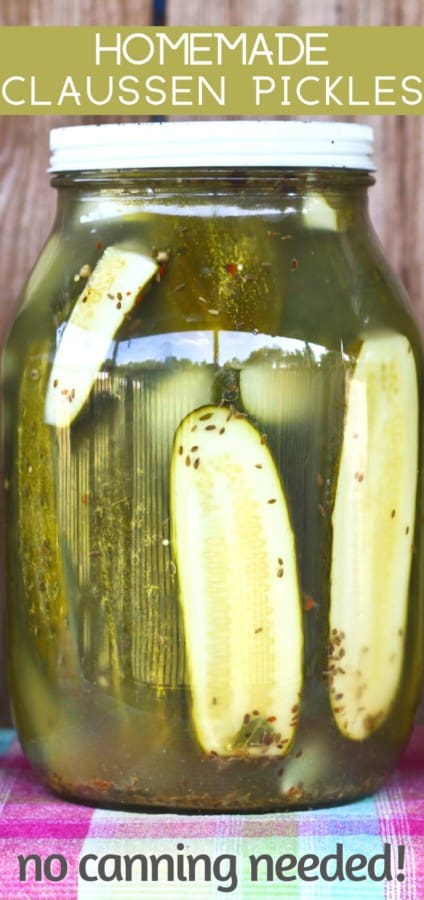
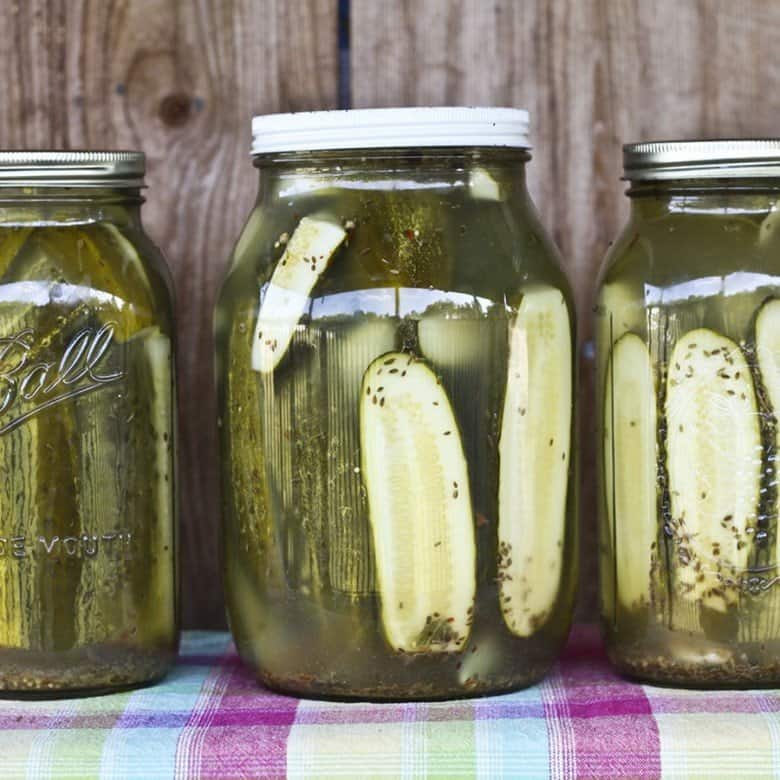
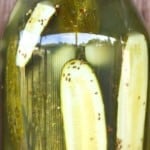



Reader's Thoughts...
Bill says
Thank you! This recipe was easy and my pickles are made and fermenting! I was a little confused on the amount of pickling spice and dill seed to place in each jar? I winged it and hope they are good.
Rebecca says
Hi Bill! Thanks for taking the time to rate the recipe! I’m sure you’ll love them!
Casey says
This was my 1st time pickling anything and I’ll say it was a delightful experience! I did bite off more than I could (proverbial) chew as this makes ALOT of brine. I had english cucumbers and a 3 pack of skinnier long ones from Costco. (I couldn’t easily find “pickling” pickles at my stores). I used the English as thicker pickle chips and the costcos into spears. I got creative: I had 6 pint jars and 1 quart. Decided to make 2 pints of chips…1 with a couple slices of fresh jalapeño and the other with a half teaspoon of red pepper flakes AND a couple jalapeño slices. Needless to say I was shocked at how much flavor they soaked up AND the amount of heat. Caliente lol. After 2 days the chips were ready for the fridge but the spears (from Costco cukes) were still pretty cucumber tasting so they sat another day. I did get fuzz on 5 of the 7 jars that freaked me out some but I didn’t know how to really weigh them down in the little jars. I removed the pickles that had it directly on them and spooned out any I saw on top of the liquid. Overall a really fun experience and I learned ALOT! The most important thing…the pickles were really good! The pickles chips with the English for the win!
Rebecca says
I’m so glad you loved it, Casey! Thanks for taking the time to rate the recipe and tell us! I love your creativity!
Davey says
I reviewed these a couple years ago, but I’ve made a few more batches so far this summer, and just wanted to say again that these are absolutely delicious. They are crisp and tangy and perfect. As good as any dill pickle you would get at a deli, and miles above the standard jarred pickle at the store. It sounds ridiculous, but it makes me happy eating a dill pickle that I made myself, especially given that they are so easy to make. I’ve never had a batch go bad or moldy, so some of the comments baffle me. Just follow the basic procedure – use fresh cukes, wash them, trim them, measure your salt and water accurately, and keep them covered on the counter out of direct sunlight for a few days. That’s it. This recipe is no-fail.
B Sunny says
Hey there!!!
I’m so happy to have found this recipe again after having used it & loved it last year! I’m looking forward to doing it again, but wanted to ask about the cider vinegar versus white vinegar.
Last year I use the white vinegar, as our family does not usually like anything sweet in our savory foods. We use apple cider vinegar as a drink mixed with seltzer occasionally, so we are accustomed to the taste, but I was afraid to use it in this recipe due to the sweetness. What do you think the difference is between using the difference vinegars? Does the ACV elevate it?
Thank you so much for sharing, & thanks Aunt J for all the uses for leftover brine!
Rebecca says
Hi B Sunny! I do not find them to be sweet, but I will say that white vinegar has a sharper taste than apple cider vinegar. If you prefer that sharper edge rather than the more rounded acidity of the acv, you may want to stick with the white vinegar!
Rebecca says
I should also mention I just really love the ACV in these pickles. It might be worth you doing smaller jars using both options to see which you prefer!
Laura slusser says
Can you use whole cucumbers in the clauses knockoff
Jilly says
Hi, this recipe sounds amazing! Claussen dill, pickle perfection 🙂 Found this recipe while searching for pickle juice for pickleback shots….crunchy dills make it sound perfect! So my question is, will the brine work for that purpose and what would be the shelf life when refrigerated? Thanks so much!
Rebecca says
Hi Jilly! The brine is delicious and I drink it! The shelf life when refrigerated is at least a month. 🙂
Jilly says
Awesome, thanks!!
Laura slusser says
Can you use whole cucumbers for pickling clauses knock off
Rebecca says
Hi Laura- You betcha!! Just be sure to trim the blossom ends!!
Laura slusser says
Okay can’t wait to try them that’s my daughter’s favorite pickle. I will let you know how mine turned out. Have a great day.
Ashley says
Made this recipe. Just put them in the fridge today. The one I tasted was excellent! But, why is my other jar all of a sudden cloudy overnight?!
Rebecca says
Hi Ashley- That’s a natural by-product of fermentation. No worries!!!
Michael Voelker says
What is the issue with using dill weed?
Rebecca says
Hi Michael- Dill weed has two issues. First and most importantly, it doesn’t pack the flavour punch of the seeds. Second, it’s messier in the final product. I generally add a little fresh dill weed if it’s handy, but I’m happier to be able to add a seed head or dill seed!
Kath says
Can I use cut up garlic in a jar instead of whole coves?
Rebecca says
Hi Kath- I don’t recommend using it in this recipe because the stuff that’s cut up in cloves is already in a preservative of some form or another. That’s not an issue when you’re cooking with it, but when you’re looking to get a little happy fermentation going, it can get in the way. 🙂
joe says
Hello there! We just finished the 3 days on the counter. When you move the jars into the refrigerator, do you keep the fermentation weights on top (and under the lids, of course), or should you remove them? Just wondering if you need to keep doing everything you can to continue to keep the pickles submerged.
Rebecca says
Hi Joe- You can remove those weights and let them float in the refrigerator. Happy Pickling!
Joe says
Thanks a ton – we can’t wait to try them!
barry says
Should left over brine (i.e., the salt, raw vinegar and water mixture) be refrigerated? I only had enough cucumbers for three quarts of pickles and have a good bit of brine remaining. It will take several days to grow enough cucumbers for another batch and I would like to use the left-over brine. Can I just leave it on the counter?
Rebecca says
Hi Barry- I’m inclined to suggest you refrigerate it for optimal results!
big_t says
I tried this and left them on the counter for 3 days. After refrigerating and tasting, the seeds/pulp is quite mushy and there seems to be an ‘off’ taste. What did I do wrong?
Rebecca says
Hi Big-T… without me being there it’s kind of difficult for me to pinpoint it, but I can offer some common issues:
1) You may have used older cucumbers. This is best made with cucumbers that have been picked (ideally) the same day or (at most) a few days ago and refrigerated promptly after picking.
2) You may need to cut a larger disc off of the blossom end of the cucumber to remove the enzyme that makes pickles mushy.
3) It may be an unspecified issue with the cucumbers themselves. Maybe a weird variety for pickling? Or a non-pickler?
4) You might have an especially hot or humid environment. In this case, sit them out at room temp for 1 day then transfer to the refrigerator. Let the process move a little more slowly in the fridge.
…. do any of these sound like possibilities to you?
Pickler says
I love salty……in fact I’m known for too much,but this was too much even for me.
You probably want to cut back on the salt.
Rebecca says
Hi Pickler- Can I ask what brand/type of salt you used? It may be that caused your issue. 🙂 I make mine exclusively with Morton’s Kosher Salt. Also, another issue several folks have run into is when they mix the brine in and among the cucumbers instead of mixing the brine with the water separately as directed and only pouring in as much brine as is needed to submerge the cucumbers.
MeggaZappin says
Perfect write-up and great recipe! I made a separate batch with some sunburst squash and they turned out really nice too!
Rebecca says
Thanks for taking the time to rate the recipe and let me know you love it, MeggaZappin 🙂 I love the idea of squash pickles, too!
Jim says
As of April 2022 I found out that Claussen Pickles are NO LONGER AVAILABLE!!! The Company has discontinued them.
Rebecca says
Hi Jim- I know Claussen has had some shortage issues these past couple of years, but it’s due mainly to the lack of jars needed more than anything else. And they’re definitely not discontinued- just tougher to find! At any rate, whatever the reason you can’t find them on the shelves, there’s no reason to go without! Just make some!
Aunt J says
Another tip: NEVER discard this brine, even after you eat all the pickles. If you like pickled eggs, throw some peeled, hard cooked eggs in this brine and let them pickle in the back of your fridge for a month or so. Include some when brining chicken or when preparing a vinaigrette. It will take pasta salad, three bean salad, cole slaw, etc. up a notch. It could even be popular addition to a Bloody Mary. If you are inclined to add a dash of vinegar to a bowl of hearty of ham and beans, try this instead. After hanging out with the garlic and spices for several months, this brine is an invaluable ingredient. In addition to being a Gatorade substitute.
Rebecca says
Thanks so much for taking the time to let everyone know these awesome uses for the brine, Aunt J!!!!
Aunt J says
Our family loves these pickles. Because we like spicy pickles, I added a quartered jalapeno to each pint. That was such a popular variation, I decided to try pickling jalapenos in this brine and kickles were born. I sliced a big harvest of jalapenos with my mandoline and followed this brine recipe. Kickles are now a favorite condiment on grilled chicken, burgers, peanut butter stuffed celery, scrambled eggs, bagles with cream cheese and even sliced fresh apples for a surprising sweet and salty treat. Yippee for this recipe.
Rebecca says
Hey Aunt J!! Thanks so much for taking the time to rate the recipe and let me know you love it! And thank you for the super fun riff on the recipe! I’ll have to give that a go this year!
Beth says
Hi! I’m anxious to try this recipe out. One question though… is RAW cider vinegar the same as RAW APPLE cider vinegar??? I can’t find raw cider vinegar anywhere. Please advise. Thanks!!
Rebecca says
Hi Beth- It sure is the same thing! It’s funny how many different names a vinegar can have, isn’t it?
Rochelle Diaz says
Hi! Is there a brand of pickling spices you use or recommend?
Rebecca says
Hi Rochelle- I’m not really brand loyal to pickling spices. I’ve used McCormick and bulk pickling spice both, and been quite happy with it. 🙂 If you buy McCormick, it’s likely to be replaced more often at the store, though, which is good for freshness!